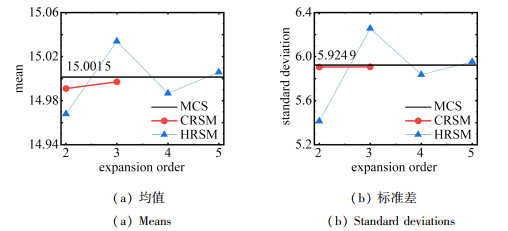A Chaotic Response Surface Method for Non-Gaussian Stochastic Analysis of Structural Responses
-
摘要: 传统响应面法应用于非Gauss随机结构时影响计算效率和精度. 为此,提出了非Gauss响应量分析的混沌响应面法. 首先根据随机变量的概率分布类型构造了混合型广义混沌多项式,据此建立了非Gauss响应量的随机展开式;利用高阶一维广义混沌多项式的根构造了非Gauss基本随机变量空间的概率配点,并基于系数矩阵行满秩原则遴选非Gauss随机变量空间的最优概率配点;进而利用最小二乘法确定了响应面的待定系数,据此建立了非Gauss响应面的广义混沌表达式. 最后,通过对比分析,验证了混沌响应面法能够以较少的配点、较低的展开阶次取得更高的计算精度和效率.Abstract: A chaotic response surface method was proposed to improve the computational efficiency and accuracy of the traditional response surface method for stochastic analysis of structural responses involving non-Gaussian random variables. Firstly, the non-Gaussian response variable was expanded by a hybrid generalized polynomial chaos constructed according to the probability distribution function types of the basic random variables. Secondly, the candidate probability collocation points in the non-Gaussian probability space were determined through the combination of the roots of the 1D generalized polynomial chaos with the next higher order, then the probability optimal collocation points in the non-Gaussian probability space were picked out based on the full row rank principle of the coefficient matrix. Finally, the unknown coefficients of the proposed response surface were determined by means of the least squares method. Comparison of examples shows that, the proposed method requires fewer collocation points and lower expansion orders, and achieves higher calculation accuracy and efficiency than those of the traditional response surface methods.
-
表 1 对应不同概率分布类型的广义混沌多项式
Table 1. Generalized polynomial chaos for different probabilistic distributions
distribution generalized polynomial chaos weight function domain Gauss Hermite $(1 / \sqrt{2 {\rm{\mathsf{π}}}}) \mathrm{e}^{-\xi^2 / 2}$ (-∞,+∞) uniform Legendre 1 [-1, 1] beta Jacobi (1+ξ)β(1-ξ)α [-1, 1] exponential Laguerre e-ξ [0,+∞) Gamma generalized Laguerre ξαe-ξ [0,+∞) 表 2 2维3阶广义混沌多项式
Table 2. The mixed generalized polynomial chaos (m=2, p=3)
Ψ3(ξ1, ξ2) α=(α1, α2) H3(ξ1)L0(ξ2)=(ξ13-3ξ1)×1 (3, 0) H2(ξ1)L1(ξ2)=(ξ12-1)×ξ2 (2, 1) $H_1\left(\xi_1\right) L_2\left(\xi_2\right)=\xi_1 \times \frac{1}{2}\left(3 \xi_2^2-1\right)$ (1, 2) $H_0\left(\xi_1\right) L_3\left(\xi_2\right)=1 \times \frac{1}{2}\left(5 \xi_2^3-3 \xi_2\right)$ (0, 3) 表 3 CRSM与HRSM计算功能函数F2的结果
Table 3. Results of the CRSM and the HRSM for F2
method total probability collocation point optimal probability collocation point mean standard
deviationcollocation
point numbermean standard
deviationcollocation
point numberMCS 3.444 5×103 2.598 7×103 103 - - - HRSM2 3.211 2×103 2.656 3×103 9 3.195 5×103 2.648 8×103 6 HRSM3 3.548 6×103 2.501 9×103 16 3.534 0×103 2.488 9×103 10 HRSM4 3.411 9×103 2.682 1×103 25 3.410 7×103 2.676 2×103 15 HRSM5 3.457 0×103 2.539 5×103 36 3.454 1×103 2.538 7×103 21 HRSM6 3.445 4×103 2.639 2×103 49 3.445 3×103 2.639 6×103 28 CRSM2 3.445 1×103 2.588 8×103 9 3.445 1×103 2.588 8×103 6 CRSM3 3.444 3×103 2.592 6×103 16 3.444 3×103 2.592 6×103 10 表 4 随机变量的统计特性
Table 4. Statistical characteristics of random variables
random variable distribution mean coefficient of variation Eb Gauss 20 GPa 0.15 Ec Gauss 22 GPa 0.15 P1 beta 10 kN 0.15 P2 beta 100 kN 0.15 q uniform 8.0 N/m 0.15 表 5 顶层水平位移u的统计特征值
Table 5. Statistical parameters of horizontal displacement at top floor
method total probability collocation point optimal probability collocation point mean/m standard
deviation/mcollocation
point numbermean/m standard
deviation/mcollocation
point numberMCS 5.472 5×10-3 1.040 9×10-3 105 - - - HRSM2 5.473 3×10-3 9.000 4×10-4 243 5.480 8×10-3 8.878 8×10-4 21 HRSM3 5.474 7×10-3 1.144 3×10-3 1 024 5.459 4×10-3 1.134 1×10-3 56 HRSM4 5.478 5×10-3 9.934 5×10-4 3 125 5.477 6×10-3 9.783 1×10-4 126 HRSM5 5.476 2×10-3 1.082 1×10-3 7 776 5.477 8×10-3 1.083 2×10-3 252 CRSM2 5.471 9×10-3 1.052 4×10-3 243 5.471 9×10-3 1.024 0×10-3 21 CRSM3 5.472 2×10-3 1.040 7×10-3 1 024 5.473 9×10-3 1.041 5×10-3 56 -
[1] ZHAO Z, LU Z H, ZHAO Y G. Simulating multivariate stationary non-Gaussian process based on wavenumber-frequency spectrum and unified Hermite polynomial model[J]. Probabilistic Engineering Mechanics, 2022, 69: 103272. [2] GHANEM R G, SPANOS P D. Spectral stochastic finite-element formulation for reliability analysis[J]. Journal of Engineering Mechanics, 1991, 117(10): 2351-2372. [3] LU N, LI Y F, HUANG H Z, et al. AGP-MCS+D: an active learning reliability analysis method combining dependent Gaussian process and Monte Carlo simulation[J]. Reliability Engineering & System Safety, 2023, 240: 109541. [4] LI X, GONGC L, GU L X, et al. A sequential surrogate method for reliability analysis based on radial basis function[J]. Structural Safety, 2018, 73: 42-53. [5] LI J, CHEN J. Stochastic Dynamics of Structures[M]. New York: John Wiley & Sons, 2009. [6] CHENG H, YANG D X. Direct probability integral method for stochastic response analysis of static and dynamic structural systems[J]. Computer Methods in Applied Mechanics and Engineering, 2019, 357: 112612. [7] BUCHER C G, BOURGUND U. A fast and efficient response surface approach for structural reliability problems[J]. Structural Safety, 1990, 7(1): 57-66. [8] ISUKAPALLI S S, ROY A, GEORGOPOULOS P G. Stochastic response surface methods (SRSMs) for uncertainty propagation: application to environmental and biological systems[J]. Risk Analysis, 1998, 18(3): 351-363. [9] HAMPTON J, DOOSTAN A. Compressive sampling of polynomial chaos expansions: convergence analysis and sampling strategies[J]. Journal of Computational Physics, 2015, 280: 363-386. [10] SU G, YU B, XIAO Y, et al. Gaussian process machine-learning method for structural reliability analysis[J]. Advances in Structural Engineering, 2014, 17(9): 1257-1270. [11] DENG J, GU D, LI X, et al. Structural reliability analysis for implicit performance functions using artificial neural network[J]. Structural Safety, 2005, 27(1): 25-48. [12] 陶然, 周焕林, 孟增, 等. 基于响应面法和改进算术优化算法的抱杆优化设计[J]. 应用数学和力学, 2022, 43(10): 1113-1122. doi: 10.21656/1000-0887.420318TAO Ran, ZHOU Huanlin, MENG Zeng, et al. Optimization design of holding poles based on the response surface methodology and the improved arithmetic optimization algorithm[J]. Applied Mathematics and Mechanics, 2022, 43(10): 1113-1122. (in Chinese) doi: 10.21656/1000-0887.420318 [13] 王涵, 史治宇. 最优阶次多项式响应面法及其在模型修正中的应用[J]. 机械制造与自动化, 2021, 50(6): 93-98.WANG Han, SHI Zhiyu. Construction of response surface with optimal order polynomial and its application in FEM updating[J]. Machine Building & Automation, 2021, 50(6): 93-98. (in Chinese) [14] HUANG S, MAHADEVAN S, REBBA R. Collocation-based stochastic finite element analysis for random field problems[J]. Probabilistic Engineering Mechanics, 2007, 22(2): 194-205. [15] LI D Q, CHEN Y F, LU W B, et al. Stochastic response surface method for reliability analysis of rock slopes involving correlated non-normal variables[J]. Computers and Geotechnics, 2011, 38(1): 58-68. [16] XIU D, EM KARNIADAKIS G. The Wiener-Askey polynomial chaos for stochastic differential equations[J]. SIAM Journal on Scientific Computing, 2002, 24(2): 619-644. [17] JAKEMAN J D, FRANZELIN F, NARAYAN A, et al. Polynomial chaos expansions for dependent random variables[J]. Computer Methods in Applied Mechanics and Engineering, 2019, 351: 643-666. [18] 姜昌伟, 刘星, 石尔, 等. 基于嵌入式多项式混沌展开法的随机边界下流动与传热问题不确定性量化[J]. 应用数学和力学, 2021, 42(5): 481-491. doi: 10.21656/1000-0887.410217JIANG Changwei, LIU Xing, SHI Er, et al. Uncertainty quantification of flow and heat transfer problems with stochastic boundary conditions based on the intrusive polynomial chaos expansion method[J]. Applied Mathematics and Mechanics, 2021, 42(5): 481-491. (in Chinese) doi: 10.21656/1000-0887.410217 [19] SUDRET B. Global sensitivity analysis using polynomial chaos expansions[J]. Reliability Engineering & System Safety, 2008, 93(7): 964-979. [20] CHENG K, LU Z Z. Adaptive sparse polynomial chaos expansions for global sensitivity analysis based on support vector regression[J]. Computers & Structures, 2018, 194: 86-96. [21] 吕大刚. 基于线性化Nataf变换的一次可靠度方法[J]. 工程力学, 2007, 24(5): 79-86.LV Dagang. First order reliability method based on linearized Nataf transformation[J]. Engineering Mechanics, 2007, 24(5): 79-86. (in Chinese) [22] LU Z H, ZHAO Z, ZHANG X Y, et al. Simulating stationary non-Gaussian processes based on unified Hermite polynomial model[J]. Journal of Engineering Mechanics, 2020, 146(7): 04020067. [23] GAUTSCHI W. Orthogonal polynomials (in MATLAB)[J]. Journal of Computational and Applied Mathematics, 2005, 178(1/2): 215-234. [24] HADIGOL M, DOOSTAN A. Least squares polynomial chaos expansion: a review of sampling strategies[J]. Computer Methods in Applied Mechanics and Engineering, 2018, 332: 382-407. [25] YANG L F, LI Z Y, YU B, et al. Full-space response surface method for analysis of structural reliability[J]. International Journal of Structural Stability and Dynamics, 2020, 20(8): 2050096. [26] LI W X, LU Z M, ZHANG D X. Stochastic analysis of unsaturated flow with probabilistic collocation method[J]. Water Resources Research, 2009, 45(8): W08425. [27] 蒋水华, 李典庆, 周创兵. 随机响应面法最优概率配点数目分析[J]. 计算力学学报, 2012, 29(3): 345-351.JIANG Shuihua, LI Dianqing, ZHOU Chuangbing. Optimal probabilistic collocation points for stochastic response surface method[J]. Chinese Journal of Computational Mechanics, 2012, 29(3): 345-351. (in Chinese) [28] 杨绿峰, 杨显峰, 余波, 等. 基于逐步回归分析的随机响应面法[J]. 计算力学学报, 2013, 30(1): 88-93.YANG Lufeng, YANG Xianfeng, YU Bo, et al. Improved stochastic response surface method based on stepwise regression analysis[J]. Chinese Journal of Computational Mechanics, 2013, 30(1): 88-93. (in Chinese) -





 下载:
下载:










 渝公网安备50010802005915号
渝公网安备50010802005915号